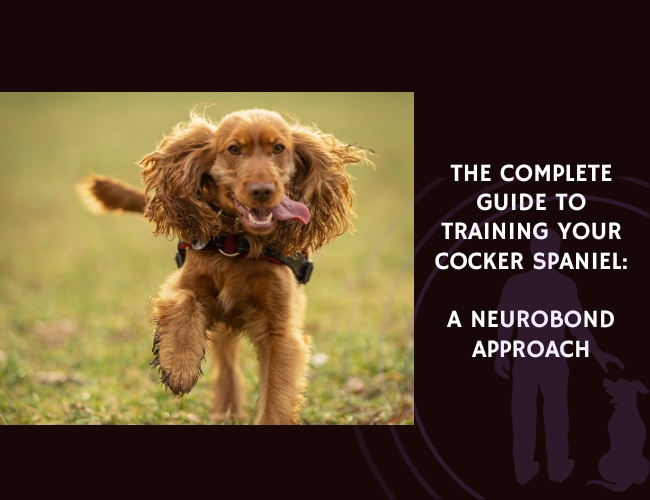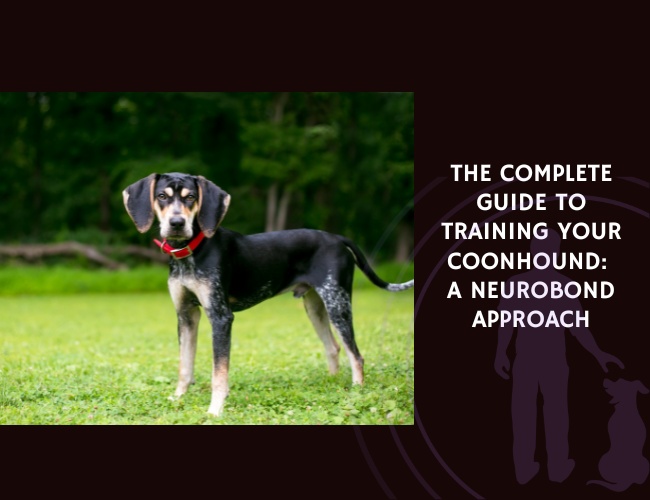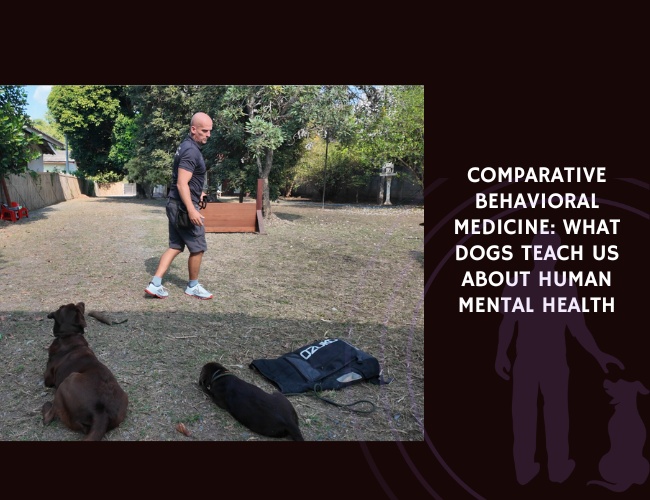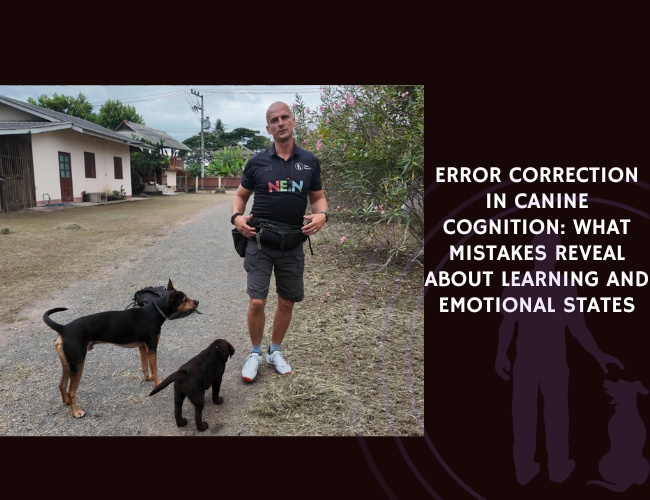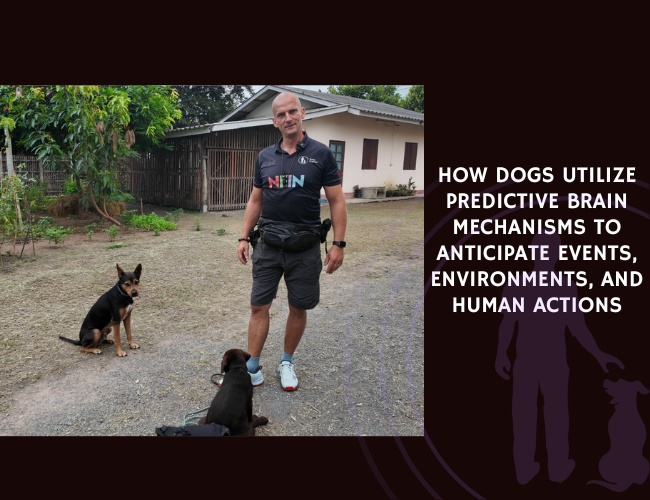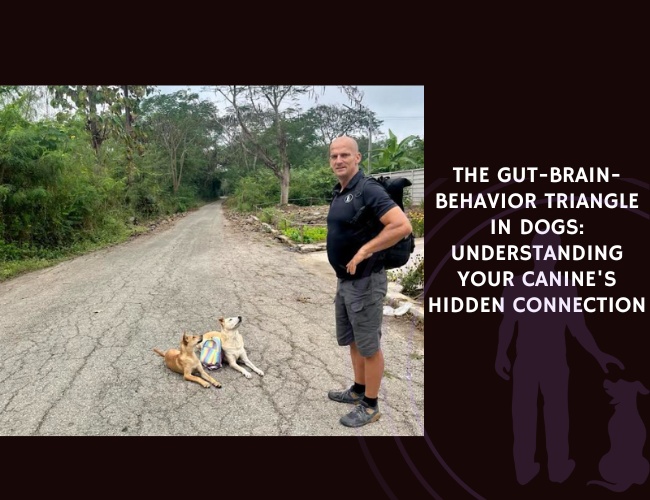Introduction: Understanding Your Cocker Spaniel’s Beautiful Mind
Your Cocker Spaniel isn’t just another dog waiting to be trained—they’re a brilliant, sensitive soul with centuries of hunting heritage flowing through their veins. Ranking among the top 25 most intelligent breeds, these gentle companions possess a unique combination of eagerness to please and independent thinking that can make training both rewarding and, let’s be honest, occasionally perplexing.
Did you know that your Cocker Spaniel’s brain processes emotional connections differently than many other breeds? Their heightened sensitivity means they’re not just learning commands—they’re reading your energy, memorizing your patterns, and forming deep neural pathways that connect their behaviors directly to their relationship with you. This is where the NeuroBond approach becomes transformative: instead of forcing obedience, we’re building an invisible leash of trust that honors their natural instincts while creating the partnership you’ve always dreamed of.
Whether you’re navigating the excitable “busy, busy, busy” personality or nurturing a more sensitive, thoughtful Cocker, this guide will show you how to work with their nature, not against it. Let us guide you through a training journey that transforms pulling, distraction, and selective listening into connection, cooperation, and joyful companionship. 🐾
Character & Behavior: The Cocker Spaniel Operating System
Understanding the Two Personality Types
Your Cocker Spaniel likely falls into one of two distinct temperament categories, and recognizing which one you’re working with fundamentally changes your training approach. The first type—those “busy, busy, busy” individuals—approach life like enthusiastic detectives, nose to the ground, tail wagging at warp speed. These dogs aren’t being disobedient when they ignore your recall; they’re simply running a different operating system that prioritizes sensory input over human commands.
The second type, our sensitive souls, process the world through an emotional filter first. These Cockers might freeze when overwhelmed, show submissive behaviors when confused, or retreat when training becomes too intense. They’re not weak—they’re actually demonstrating a sophisticated emotional intelligence that, when properly channeled through the NeuroBond method, becomes their greatest strength.
The Hunter’s Brain in Your Living Room
Instinct as teacher: Your Cocker’s hunting heritage isn’t a training obstacle—it’s your secret weapon. That nose that pulls them toward every fascinating scent? It’s the same drive that makes them exceptional problem-solvers. Research shows Cockers can learn tasks twice as fast as many breeds, but here’s the catch: they learn what they find valuable, not necessarily what we’re trying to teach.
Memory and observation: Scientists have documented that Cocker Spaniels possess exceptional observational learning abilities. They’re watching you even when you think they’re distracted. They’ve memorized that you always grab the leash from the third hook, that treats come from your right pocket, and that your shoulders tense before you’re about to call them away from something interesting. This hyperawareness means every interaction is a training moment—not just the formal sessions.
Problem-solving logic: When your Cocker figures out how to open the baby gate or discovers that jumping gets attention, they’re not being naughty. They’re demonstrating exactly the kind of intelligent problem-solving their ancestors used to track game birds through dense undergrowth. The NeuroBond says: don’t punish this intelligence—redirect it toward solutions you both can live with.
Building the NeuroBond Foundation
The Invisible Leash Begins Here
Before you teach a single command, before you even think about heel position or recall, you must establish what we call the NeuroBond—that invisible thread of connection that makes everything else possible. For Cocker Spaniels, with their deep capacity for attachment and their sensitivity to human emotions, this bond becomes the cornerstone of all learning.
Start by simply existing together without agenda. Sit on the floor during their calm moments. Let them investigate you without forcing interaction. When they choose to make eye contact—even for a split second—mark this moment with quiet acknowledgment. Not treats, not excitement, just gentle recognition. You’re teaching them that checking in with you is inherently valuable, that you’re a safe harbor in their world of fascinating distractions.
Trust Through Consistency
Creating predictable patterns: Your sensitive Cocker needs to know what to expect from you. This doesn’t mean rigid rules—it means consistent energy and predictable responses. When they bring you their toy for the fifteenth time, your response should feel familiar and safe. This predictability allows their nervous system to relax, creating the optimal state for learning.
The power of allowing: Here’s where traditional training fails Cockers: it tries to suppress their nature. The NeuroBond method says, “Let the dog be.” When your Cocker wants to sniff during a walk, don’t immediately pull them away. Count to three, then invite them to continue with you. You’re not being permissive—you’re acknowledging their needs while establishing yourself as a trustworthy guide who understands their world.
From Connection to Communication
Once your Cocker starts naturally checking in with you—glancing back on walks, coming to find you in the house, seeking your guidance when uncertain—you’ve established the foundation. This isn’t obedience; it’s relationship. Now, every behavior you want to shape can flow through this connection rather than being imposed upon it. 🧡
Early Development & Critical Windows
The 3-14 Week Revolution
If you’re bringing home a Cocker Spaniel puppy, you’re standing at the threshold of the most crucial developmental period in your dog’s entire life. Between 3 and 14 weeks, your puppy’s brain is essentially downloading their understanding of the world—and this download is largely permanent. Research indicates that experiences during this window, particularly between weeks 5-16, create neural pathways that will influence behavior for life.
But here’s what makes Cockers unique: their sensitivity means these early experiences imprint even more deeply than in less emotionally-attuned breeds. A harsh correction at 8 weeks (during their first fear period) doesn’t just create a bad memory—it can fundamentally alter how they process training situations forever. Conversely, positive experiences during this time become the bedrock of confidence and resilience.
The NeuroBond During Critical Periods
Week 3-7 (with breeder): Even before your puppy comes home, their NeuroBond capacity is developing. Puppies who experience gentle handling, varied textures, and different sounds during this period arrive pre-programmed for connection.
Week 8-10 (homecoming): Your Cocker puppy arrives during a fear period. Traditional training says start immediately with sits and stays. The NeuroBond approach says: just be. Let them explore their new world with you as their secure base. Every positive interaction now is worth a hundred training sessions later.
Week 11-14 (social learning peak): This is when your Cocker’s brain is most receptive to learning about their place in your family system. Not through formal commands, but through lived experience. Standing on the leash teaches self-settling. Following you room to room establishes you as worthy of attention. These aren’t tricks—they’re relationship blueprints.
Working with Adult Cockers
Did you adopt an adult Cocker or miss those early windows? Don’t despair. While those early weeks are powerful, your Cocker’s emotional intelligence means they remain remarkably capable of forming new neural pathways throughout life. The key difference? Adult learning requires more patience and more consistent emotional availability from you.
An adult Cocker who pulls on walks has likely been solving the “problem” of interesting smells their own way for years. You’re not just teaching loose leash walking—you’re offering them a completely new solution to a problem they didn’t know existed. This requires trust, which for an adult dog, must be earned through hundreds of small, consistent interactions.
The NeuroBond Training Method in Practice
Instinct-Guided Learning
The revolutionary aspect of NeuroBond training is that we don’t suppress your Cocker’s instincts—we use them as the pathway to learning. That obsessive sniffing isn’t a distraction; it’s a training opportunity. Here’s how:
The Scent Trail Exercise: Instead of fighting your Cocker’s need to sniff, create structured scent games. Hide treats along a specific path. Your dog learns that following scents WITH you (not despite you) leads to rewards. You’re not training them to ignore scents—you’re teaching them that you’re part of the hunting party.
The Natural Settle: When your Cocker is pulling and excited, don’t yank the leash or command “sit.” Simply stand still, step on the leash with enough slack that they can stand, sit, or lie down. Wait. Their own instinct will guide them to settle—they’ll try standing (uncomfortable with the limited leash), then sitting, then eventually lying down. The moment they settle, the walk continues. You didn’t force anything; their own problem-solving led them to the solution.
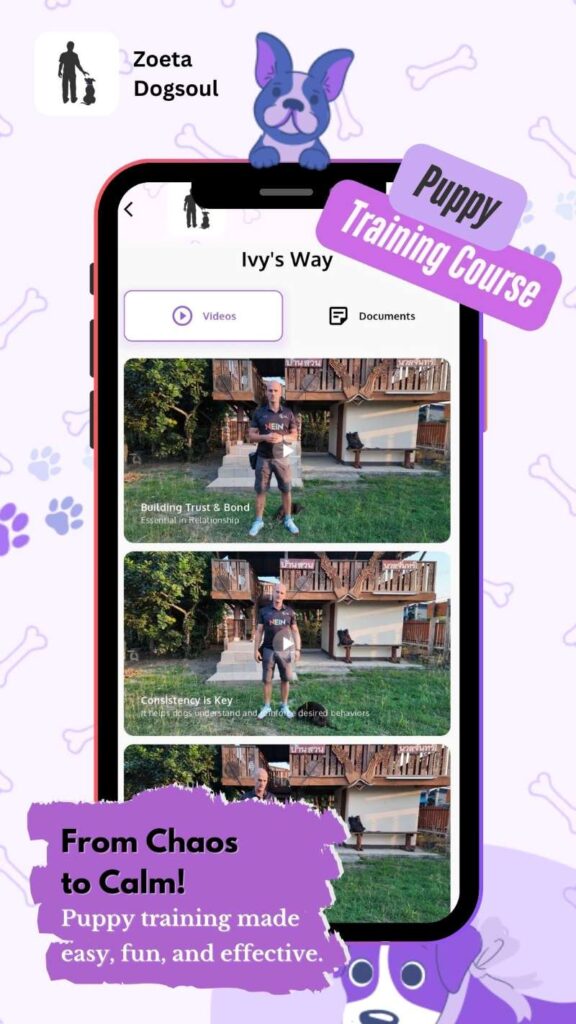
Communication Without Commands
Traditional training relies on verbal commands, but Cockers—with their exceptional observational skills—learn better through patterns and energy. Consider this approach:
The Check-In System: Throughout the day, when your Cocker naturally looks at you, mark it with a quiet “yes” or a gentle touch. No treats necessary. You’re building an invisible communication system where your dog’s default behavior becomes referencing you. This isn’t a command—it’s a conversation.
Body Language Conversations: Your Cocker is already reading your body language with remarkable accuracy. Use this. Turn your shoulders to indicate direction changes on walks. Slow your breathing to help them calm. Speed up your movement to invite play. You’re speaking their primary language—and they’re brilliant at it.
Addressing Breed-Specific Challenges
The Distraction Dilemma: Your Cocker’s distractibility isn’t defiance—it’s bandwidth. Their sensory processing system is taking in massive amounts of information. The NeuroBond solution? Reduce competing input gradually. Start training in boring environments, then slowly add distractions as their connection to you strengthens. You’re not teaching them to ignore the world; you’re teaching them that you’re the most interesting thing in it.
Selective Listening Solutions: When your intelligent Cocker “chooses” not to listen, they’re actually making a cost-benefit analysis. Is coming when called more valuable than investigating that fascinating smell? Make yourself more valuable—not through treats, but through becoming genuinely exciting. Run away when calling them. Hide behind trees. Be unpredictable and fun. You’re not bribing; you’re becoming inherently rewarding.
Advanced Behavioral Shaping
Resource Guarding: A Trust Issue, Not a Training Issue
Some Cockers develop possessive behaviors around food, toys, or even people. Traditional training says dominate the resource. The NeuroBond approach recognizes this as a trust deficit that requires relationship repair, not behavioral suppression.
The Addition Method: Instead of taking things away (which confirms their fear that you’re a threat to resources), add value. Dog has a toy? Offer a treat near them, then walk away. Eating dinner? Drop an extra special bonus in their bowl and leave. You’re teaching them that your approach means good things happen—resources increase rather than decrease.
Trading Up: Teach your Cocker that giving up something good means getting something better. Start with low-value items. They have a sock? Offer a treat trade. Gradually work up to higher-value items. You’re not teaching “drop it”—you’re building trust that you’re a source of abundance, not scarcity.
Noise Sensitivity: Rewiring Fear Through Connection
Cocker Spaniels’ sensitivity extends to sound, with many developing anxiety around loud noises. The NeuroBond approach doesn’t desensitize through flooding but builds resilience through connection.
The Safety Signal: During calm times, establish a specific touch or position that means “you’re safe with me.” Practice this repeatedly when nothing scary is happening. When frightening sounds occur, offer this same signal. You’re not telling them not to be scared; you’re offering yourself as a shelter.
Recovery Rather Than Prevention: You can’t prevent all scary sounds, but you can teach recovery. After a startling noise, engage in a favorite calm activity together. Gentle brushing, quiet puzzle games, or synchronized breathing. You’re teaching their nervous system that scary things end and calm returns—with you as the constant.
Exercise & Mental Stimulation Integration
Honoring the Working Heritage
Your Cocker Spaniel’s ancestors worked all day alongside hunters, using both their bodies and their brilliant minds. Modern life rarely provides this level of engagement, leading to many behavioral challenges that are simply expressions of unfulfilled needs. The NeuroBond approach doesn’t just tire them out—it fulfills their deepest instincts within your relationship structure.
The Job Principle: Every Cocker needs a job, but that job should strengthen your bond, not exist separately from it. Teaching them to find hidden objects isn’t just mental stimulation—it’s collaborative hunting. Carrying a small backpack on walks isn’t just exercise—it’s working alongside you with purpose.
Structured Activities That Build Connection
The Search Partnership: Hide yourself in the house and call your Cocker once. Their hunting instinct kicks in, but they’re hunting for YOU. This isn’t recall training—it’s reinforcing that you’re worth finding. Gradually make hiding spots more challenging. Celebrate dramatically when they find you. You’re becoming the ultimate prize.
Retrieval With Purpose: Cockers were born to retrieve, but mindless ball throwing creates obsession, not connection. Instead, establish retrieval as a conversation. They bring the ball to your hand (not drop it at your feet). You examine it together like it’s treasure. Sometimes you throw it, sometimes you pocket it and walk on, sometimes you trade it for something else. The game becomes about interaction, not just the chase.
Synchronized Movement: Walk in patterns with your Cocker off-leash in safe spaces. Figure-8s, spirals, sudden direction changes. No commands—just movement they choose to mirror. This builds the invisible leash stronger than any physical tether could. You’re dancing together, and they’re choosing to follow your lead.
Troubleshooting Common Challenges
When Progress Stalls: Understanding Plateau Patterns
Every Cocker Spaniel’s learning journey includes plateaus—periods where progress seems to stop or even reverse. Understanding these as natural parts of neural development, rather than training failures, changes everything about how you respond.
The Integration Phase: After learning new behaviors, your Cocker’s brain needs time to integrate this information into existing neural pathways. During this period, they might seem to “forget” things they knew last week. They haven’t forgotten—they’re reorganizing. Continue practicing without pressure, maintaining connection over perfection.
Sensitivity Overload: Your Cocker’s emotional awareness means they absorb not just training but also your stress, household tensions, and environmental changes. A suddenly “stubborn” dog might be processing your anxiety about a work deadline. The solution isn’t more training—it’s addressing the emotional environment first.
The “Rage Syndrome” Myth
Let’s address this directly: true rage syndrome is exceptionally rare and often misdiagnosed. What appears as unexpected aggression in Cockers is usually either resource insecurity, fear responses, or frustration from unmet needs—all solvable through the NeuroBond approach.
Reading the Precursors: Cockers always give warnings, but their sensitive nature means these might be subtle. Whale eye, lip licking, body stillness—these aren’t preparation for attack but requests for space or help. When you respond to these early signals, you prevent escalation while building trust.
Addressing True Reactivity: If your Cocker shows aggressive behaviors, this represents a breakdown in their sense of safety, not a character flaw. Return to foundation work. Reduce all pressure. Rebuild from the beginning with even more patience. You’re not fixing aggression—you’re repairing trust.
Sensitive. Smart. Connected.
Bond before commands. A Cocker Spaniel thrives when training begins with emotional connection, not control. Their sensitivity turns trust into the anchor that keeps them engaged, even in distracting environments.
Instinct is an ally. The same hunting drive that pulls them toward every scent can fuel problem-solving and cooperation when guided rather than suppressed. NeuroBond channels these instincts into shared goals.
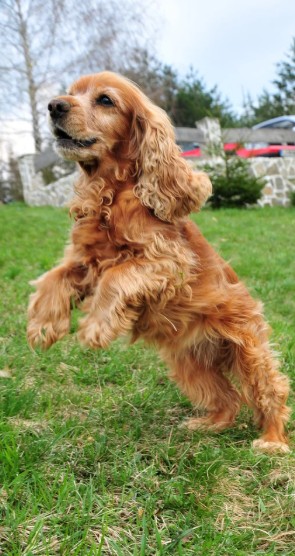

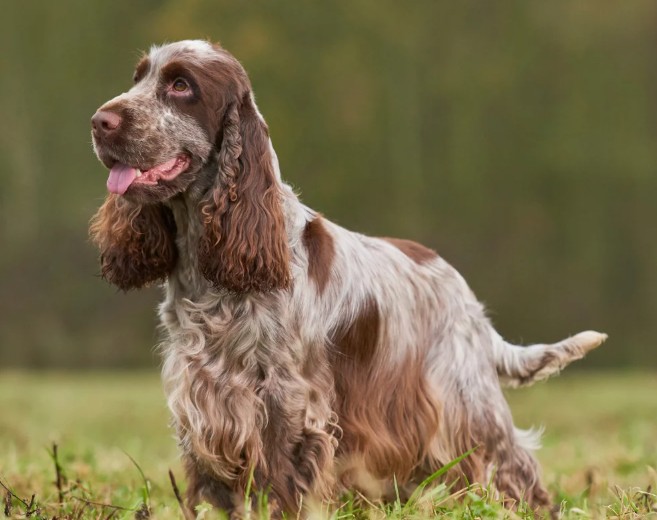
Consistency builds security. Predictable responses and respect for their natural rhythms create a safe learning space. From this calm foundation, communication flows naturally and training becomes a shared language.
Senior Cocker Considerations
Adapting the NeuroBond for Aging Minds
As your Cocker enters their senior years, their cognitive function changes, but their capacity for connection often deepens. The NeuroBond approach adapts beautifully to aging dogs because it’s based on relationship, not performance.
Cognitive Enrichment: Senior Cockers might struggle with complex tasks but excel at nosework and gentle problem-solving. Hide treats in increasingly easy spots if needed. The goal isn’t challenge—it’s engagement. Your presence during these activities matters more than their success rate.
Physical Modifications: Arthritis might limit movement, but the need for purposeful activity remains. Teach “help” tasks like picking up dropped items or carrying lightweight objects. They’re still working dogs—just with adjusted job descriptions.
Emotional Support: Senior Cockers often develop increased anxiety or confusion. Your established NeuroBond becomes their anchor. That invisible leash you built years ago now guides them through the confusion of aging. Your calm presence communicates safety when their senses fail.
The Deepening Bond
Something beautiful happens with senior Cockers trained through the NeuroBond method: the relationship transcends training entirely. Commands become unnecessary because the connection is so strong. A glance conveys what words once did. This isn’t just successful training—it’s the culmination of a lifetime of trust-building.
Creating Your Daily Training Rhythm
Morning Foundations
Your Cocker’s day should begin with connection, not commands. Before breakfast, spend three minutes in quiet togetherness. No phones, no distractions—just presence. This sets the emotional tone for everything that follows.
The Wake-Up Ritual: Let your Cocker approach you rather than you approaching them. This small choice empowers them and starts the day with agency. Follow their lead for the first few minutes—if they want to stretch, you stretch. If they want to cuddle, you cuddle. You’re acknowledging them as a participant, not just a recipient of training.
Integrated Training Moments
The NeuroBond approach means training happens continuously through your daily routine, not in isolated sessions:
Doorway Negotiations: Every doorway is a micro-training opportunity. Not through commanded sits, but through natural pausing. Your Cocker learns that doors open when calmness happens. No words needed—just patience and consistency.
Mealtime Connections: Instead of making your Cocker perform tricks for dinner, use mealtime to deepen connection. Have them follow you to the food area. Make eye contact before setting the bowl down. Sit nearby while they eat (not dominating, just present). You’re associating your presence with good things happening.
Evening Wind-Down: Cockers need help transitioning to rest. Establish a calming routine: gentle brushing, quiet massage, synchronized breathing. This isn’t just physical care—it’s teaching them to modulate their energy with your guidance.
The Weekly Training Arc
Structure your week to match your Cocker’s energy patterns and learning capacity:
Monday-Tuesday: After weekend excitement, focus on calm, foundational work. Practice presence, reinforce check-ins, enjoy quiet activities together.
Wednesday-Thursday: Peak learning days. Introduce new concepts or practice challenging behaviors. Your Cocker’s midweek energy supports focused learning.
Friday-Saturday: Social learning and application. Visit new environments, practice around distractions, but always with connection as the priority.
Sunday: Rest and integration. Minimal formal training, maximum relationship building. Let their brain process the week’s learning.
Environmental Management for Success
Creating a Learning-Optimized Space
Your home environment profoundly impacts your Cocker’s ability to learn and maintain their NeuroBond connection. These sensitive dogs absorb environmental energy like emotional sponges, making space management crucial for training success.
Safe Zones: Establish specific areas where your Cocker is never asked to perform or comply with anything. Their bed, a particular corner, or under a certain table—these become regulation zones where they can reset their nervous system. When they’re in these spaces, you only offer comfort, never training.
Transition Spaces: Doorways, hallways, and stairs become natural training zones—not through formal sessions but through consistent patterns. Your Cocker learns that certain spaces involve certain behaviors, all guided by your energy rather than commands.
Managing Multi-Dog Dynamics
If you have multiple dogs, your Cocker’s sensitivity means they’re constantly processing not just their relationship with you but also pack dynamics. The NeuroBond approach addresses this complexity:
Individual Connection Time: Each dog needs solo bonding time daily. Your Cocker especially requires these one-on-one moments to strengthen their personal connection without competing social pressures.
Parallel Training: Train dogs side by side rather than separately or in direct competition. They learn by observing each other while maintaining their individual connection to you. Your Cocker’s observational intelligence makes them excellent at learning from watching others succeed.

Nutrition and Training Performance
The Gut-Brain Connection
Your Cocker’s sensitive nature extends to their digestive system, and nutritional status directly impacts their ability to learn and maintain emotional regulation. The NeuroBond approach recognizes that training begins with biology.
Blood Sugar Stability: Cockers are prone to energy crashes that manifest as sudden stubbornness or hyperactivity. Small, frequent meals maintain steady glucose levels, supporting consistent learning capacity. Training sessions scheduled 30 minutes after small meals often yield better results than working with overly hungry or overly full dogs.
Inflammatory Foods and Behavior: Some Cockers show increased anxiety or reactivity when consuming certain proteins or grains. If training progress stalls despite consistent work, consider an elimination diet. You might discover that behavioral challenges were actually dietary reactions.
Strategic Treat Use
The NeuroBond method doesn’t rely on constant treating, but strategic use of food rewards can enhance connection:
Value Variation: Use different value treats for different achievements. Your presence and praise are the baseline reward. Regular treats mark good choices. High-value rewards celebrate breakthrough moments. Your Cocker learns that rewards exist on a spectrum, with your approval as the constant.
Portion Awareness: Cockers are prone to weight gain, which impacts both health and training motivation. Use their regular meals as training rewards when possible. They’re working for their dinner, making mealtime purposeful rather than passive.
The Science Behind Success
Neuroplasticity and the Cocker Brain
Recent neuroscience research reveals that Cocker Spaniels have particularly high neuroplasticity—their brains remain capable of forming new neural pathways throughout life. This explains why the NeuroBond method is so effective: you’re literally rewiring their brain through relationship.
Mirror Neuron Activation: Cockers have highly active mirror neuron systems, meaning they’re constantly modeling your emotional state and behavior. When you remain calm during their excitement, their neurons begin firing in patterns that mirror your calmness. You’re not training them to be calm—you’re showing their brain how to create calm states.
Emotional Contagion: Your Cocker doesn’t just observe your emotions—they experience them. This bilateral emotional exchange means your internal state during training matters more than your external technique. Frustrated energy creates frustrated dogs. Calm confidence creates calm, confident dogs.
Attachment Theory in Practice
The NeuroBond method is rooted in attachment science. Your Cocker’s behavior problems often stem from insecure attachment patterns, not training deficits:
Secure Attachment Signs: Comfortable exploring while checking in, easy to soothe when upset, seeks you when uncertain but isn’t clingy. These dogs learn easily because their nervous system isn’t occupied with attachment anxiety.
Earning Secure Attachment: Consistent availability, predictable responses, and emotional attunement build security over time. This isn’t achieved through training sessions but through thousands of small, reliable interactions. Every time you respond appropriately to their needs, you strengthen the neural pathways of trust.
Common Mistakes and Misconceptions
The Dominance Myth
Your sensitive Cocker doesn’t need an “alpha”—they need a trusted guide. Attempts to dominate or assert pack leadership often backfire, creating fearful or shut-down dogs who comply but don’t truly connect.
Leadership Through Security: True leadership means being the source of safety and good decisions. Your Cocker follows you not because you’re dominant but because history has proven you make choices that lead to positive outcomes.
The Over-Training Trap
Cocker Spaniels’ eagerness to please can tempt us into excessive training sessions. But their sensitive nervous systems need processing time:
Signs of Over-Training: Sudden “forgetfulness,” increased distractibility, or seeming depression often indicate mental fatigue, not defiance. Your brilliant Cocker’s brain needs rest to consolidate learning.
Quality Over Quantity: Three minutes of connected, purposeful interaction beats thirty minutes of repetitive drilling. The NeuroBond strengthens through presence, not practice.
Misreading Sensitivity as Weakness
Your Cocker’s sensitivity is their superpower, not a limitation. They’re not “soft” or “weak”—they’re emotionally sophisticated:
Emotional Intelligence: Your Cocker knows you’re stressed before you do. They detect illness, sense emotional changes, and respond to subtle environmental shifts. This isn’t weakness—it’s an advanced operating system that requires respectful handling.
Building Resilience: Don’t protect your sensitive Cocker from all challenges. Instead, support them through difficulties. Your presence during scary experiences teaches them they can handle hard things with you as their anchor.
Advanced NeuroBond Techniques
Energy Matching and Modulation
The subtlest and most powerful aspect of NeuroBond training involves conscious energy management. Your Cocker Spaniel is essentially an emotional barometer, constantly reading and responding to your energetic state.
The Calm-Down Protocol: When your Cocker is over-excited, don’t command “calm.” Instead, consciously slow your breathing, relax your shoulders, and soften your gaze. Stand still or sit down. Your Cocker’s mirror neurons will begin matching your state. This might take 30 seconds or 3 minutes, but it works more deeply than any command.
Excitement Calibration: Sometimes you need your Cocker alert and engaged. Instead of revving them up with voice or movement, create contained excitement through focused attention. Intense eye contact, slight forward lean, controlled energy—your Cocker learns to match your intensity without losing control.
The Invisible Conversation
Advanced NeuroBond practice means communicating almost telepathically with your Cocker:
Intention Broadcasting: Before you move, set your intention clearly in your mind. Your body language shifts subtly, and your Cocker reads these micro-signals. Think “we’re going left,” and watch your dog begin orienting that direction before you’ve taken a step.
Predictive Positioning: Your bonded Cocker begins anticipating your needs rather than just responding to commands. They move out of your path before you arrive, settle when you’re about to make a phone call, bring toys when you’re sad. This isn’t training—it’s relationship at its deepest level.
Building Confidence in Sensitive Cockers
The Courage Account
Think of confidence as a bank account. Every positive experience deposits courage; every scary or overwhelming experience makes a withdrawal. Your sensitive Cocker needs a surplus to handle life’s challenges:
Micro-Wins: Set up tiny, achievable challenges throughout the day. Successfully navigating a slightly scary sound, meeting a calm stranger, or solving a simple puzzle all deposit confidence. These aren’t training exercises—they’re courage-building experiences.
Recovery Credits: When something scary happens, how you handle recovery matters more than the event itself. Quick return to normalcy, maintenance of connection, and moving forward together teach your Cocker that scary things are survivable and temporary.
Therapeutic Interactions
For Cockers with existing anxiety or fear issues, the NeuroBond becomes genuinely therapeutic:
Co-Regulation: Your nervous system becomes the external regulator for your dog’s nervous system. Through consistent, calm presence during triggers, you teach their brain new response patterns. This is deeper than desensitization—it’s nervous system retraining.
Safe Exploration: Create controlled opportunities for your Cocker to choose courage. A slightly scary object at a distance they control, with you as their safe base. They approach at their pace, retreat when needed, always with your steady presence as their anchor. You’re teaching them they can be brave because you’re there.
The Lifetime Journey
Evolution of the Bond
The NeuroBond isn’t static—it deepens and evolves throughout your Cocker’s life:
Puppy Phase (8 weeks – 6 months): Building foundation, establishing trust, creating safety
Adolescent Phase (6 months – 2 years): Testing boundaries, reinforcing connection despite challenges, maintaining consistency through hormonal chaos
Adult Phase (2 – 8 years): Refinement, deeper communication, invisible leash strengthens
Senior Phase (8+ years): Transcendent connection, wordless communication, mutual support
Measuring Success Differently
Traditional training measures success through compliance. The NeuroBond method measures success through connection quality:
Connection Indicators: Does your Cocker check in naturally? Do they seek you when uncertain? Can they calm themselves using your presence? These matter more than perfect sits or stays.
Relationship Rhythms: You develop unique communication patterns, inside jokes, and special rituals. Your Cocker might have a specific way of asking for walks, a particular game you play together, or a silly routine that makes you both happy. These aren’t training outcomes—they’re relationship treasures.
When Challenges Persist
Sometimes, despite your best efforts, challenges remain. The NeuroBond approach says this is okay:
Acceptance With Growth: Your Cocker might always be sound-sensitive, easily distracted, or quirky in certain ways. The goal isn’t perfection but partnership. You learn to work with their nature, and they learn to trust your guidance through difficulties.
Professional Partnership: Sometimes you need help. Seeking a professional who understands connection-based training isn’t failure—it’s wisdom. Choose someone who sees your Cocker as a sensitive, intelligent being deserving of respect, not a problem to be fixed.
Conclusion: Is This Journey Right for You?
Training your Cocker Spaniel through the NeuroBond method isn’t just about creating an obedient dog—it’s about forging a partnership that honors their sensitive, brilliant nature while meeting your needs for companionship and cooperation. This approach asks more of you than traditional training because it requires emotional presence, patience, and a willingness to see training as relationship-building rather than behavior modification.
Ask yourself: Are you ready to let your Cocker teach you as much as you teach them? Can you embrace their sensitivity as strength? Will you commit to building an invisible leash of trust rather than relying on commands and control? If your answer is yes, you’re embarking on one of the most rewarding journeys possible with these remarkable dogs.
Your Cocker Spaniel’s ancestors worked alongside humans for centuries, not through dominance but through partnership. The NeuroBond method simply returns to this ancient wisdom, using modern understanding of canine neuroscience to create connections our ancestors could only dream of. Your Cocker is waiting to show you just how deep this bond can go—all you need to do is open your heart, quiet your mind, and let the journey begin.
Remember: You’re not training a dog. You’re building a relationship. You’re creating a partnership. You’re forging a NeuroBond that will transform both your lives in ways you can’t yet imagine. Trust the process, trust your dog, and most importantly, trust the connection growing between you.
The invisible leash is waiting to be woven. Together. 🐾🧡

